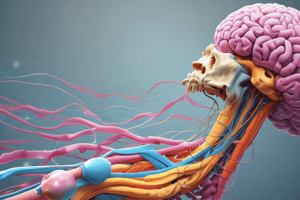Podcast
Questions and Answers
What are the two main types of somatosensory information mentioned in the lesson?
What are the two main types of somatosensory information mentioned in the lesson?
Exteroceptive somatosensory information and Propioceptive somatosensory information
Which type of skin has different complexities in terms of somatosensory receptors?
Which type of skin has different complexities in terms of somatosensory receptors?
- Skin with hair follicles
- Dermis skin
- Hair-bearing skin
- Hairless skin (correct)
Thermoreceptors respond to a wide range of temperatures.
Thermoreceptors respond to a wide range of temperatures.
False (B)
Histamine-independent itch is associated with ___________ itch.
Histamine-independent itch is associated with ___________ itch.
Match the following areas with their respective somatosensory representations:
Match the following areas with their respective somatosensory representations:
What are the main types of analgesics mentioned in the text?
What are the main types of analgesics mentioned in the text?
Where do opioids primarily act according to the text?
Where do opioids primarily act according to the text?
True or False: Opioids are mentioned to have a key role in pain management.
True or False: Opioids are mentioned to have a key role in pain management.
Analgesics reduce/block __________ perception.
Analgesics reduce/block __________ perception.
Match the analgesic with its primary action level:
Match the analgesic with its primary action level:
Study Notes
Somatosensory Information
- Somatosensory information senses different modalities in somatic body regions, including skin, muscles, and joints.
- Exteroceptive somatosensory information includes touch, pressure, vibrations, temperature, and pain.
- Proprioceptive somatosensory information includes continuous detection of degree of contraction, muscular tension, and joint position.
Somatosensory Receptors
- Somatosensory receptors are distributed differently in hair-bearing and hairless skin.
- Hair-bearing skin has free nerve endings associated with hair follicles, while hairless skin has different complexities found in the dermis or intersection with the epidermis.
Somatosensory Perception Modalities
- Somatosensory perception modalities include shape, texture, movement, vibration, temperature, pain, and itch.
- Molecules involved in sensing are likely to be relatively inespecific ionic (cationic) channels.
Mechanoreceptors
- Mechanoreceptors include Pacinian corpuscles, Meissner's lamellae, and keratinocytes.
- Pacinian corpuscles are involved in adaptation, and Meissner's lamellae can fire action potentials.
- Keratinocytes may be sensory cells.
Temperature Sensing
- Thermoreceptors respond to local changes in temperature.
- Each receptor responds to a defined temperature range, with small receptive fields occupied by "cold" or "warm" receptors.
- Cold receptors are more abundant than warm receptors.
Pain Processing
- Pain is a special sensory modality that conveys signals to indicate tissue damage.
- Pain information is processed using the anterolateral pathway.
- Pain sensing neurons (nociceptors) can detect different modalities, including mechanical, temperature, and chemical stimuli.
- UNIMODALS use Aδ fibers, while POLYMODALS use C fibers.
Pain Signal Propagation
- There are two kinds of painful sensations: sharp pain (fast) and slow pain (sustained).
- Painful stimuli initiate a negative emotional sensation, particularly slow pain.
- TRPV1 receptors are characteristic of nociceptors.
Nociceptive Integration in the Spinal Cord
- Gate control theory suggests that mechanical stimuli can influence nociceptors.
- There is a lack of knowledge about the interneurons involved.
Descending Pathways and Pain Modulation
- Descending pathways that modulate spinal pain processing can be either inhibitory or facilitatory.
- Starting from upper levels (cortex and limbic areas), they converge upon the periaqueductal gray matter (PAG).
- PAG activates noradrenergic and serotoninergic nuclei that modulate (i.e., inhibit) dorsal horn neurons.
Integration of Pain Pathways
- The existence of several areas involved allows for the modulation of pain at different levels.
- PAG plays a central role in pain processing.
- At the molecular level, endogen opioids play a key role (i.e., placebo).
Visceral Pain
- Visceral pain is signaled as pain in somatic regions (referred pain).
- Visceral nociceptive signals converge with somatic pathways in the spinal cord.
- Examples include heart attack or hiatal hernia (heartburn) pain.
Pain Management
- Analgesics act upon pain pathways, including opioids, NSAIDs, TCA, and SNRIs.
- Opioids are the most potent, but don't work well for neuropathic pain.
- Antidepressives are being used for pain management.
- Intensive research is ongoing into the mechanisms of cannabinoids in pain relief.
Studying That Suits You
Use AI to generate personalized quizzes and flashcards to suit your learning preferences.
Description
This quiz covers the features of somatosensory information, including exteroceptive and proprioceptive somatosensory information, and their relation to skin, muscles, and joints.





